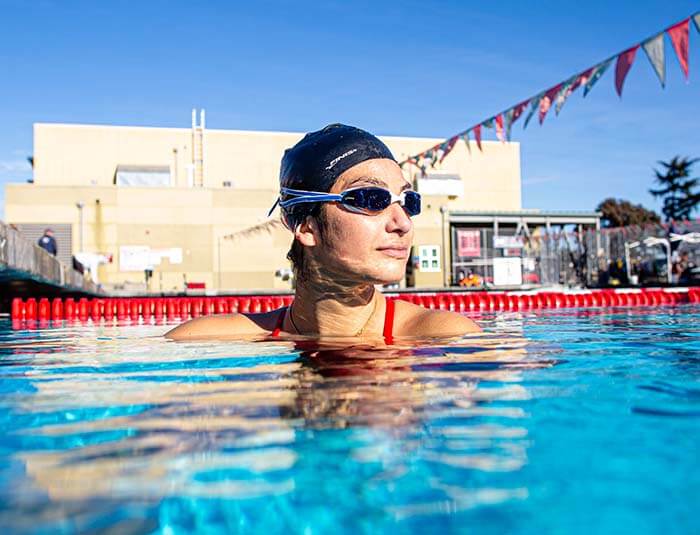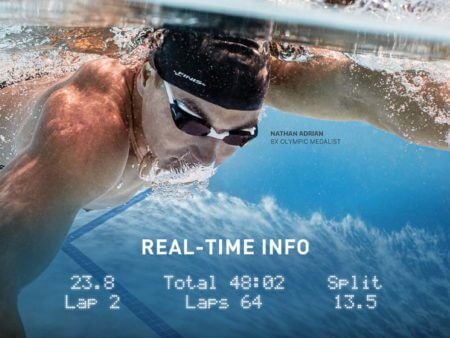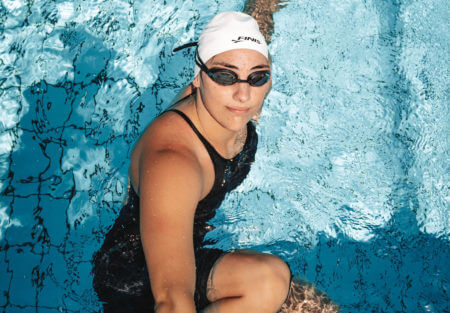Monofin to Smart Goggle to HydroX: FINIS Defined as World-Class Brand Through Constant Innovation

Monofin to Smart Goggle to HydroX: FINIS Emerges as World-Class Brand Through Constant Innovation
Years before FINIS was a major player in the swimming apparel market with numerous training and racing products benefitting swimmers around the world, the company originated when two friends met up after one had returned from winning Olympic gold. Pablo Morales had retired after missing the Olympic team in 1988, but three years later, he returned to the sport, and he captured 100 butterfly gold in 1992.
After the Barcelona Games, Morales visited with John Mix, an old friend from growing up in Northern California, and Mix asked Morales about a piece of equipment he encountered while playing water polo in Europe.
“I asked him, ‘Did you ever use a monofin in your training?’” Mix recalled. “He said, ‘I don’t know what a monofin is.”
Mix shared a monofin he had brought back from Europe, and Morales tried it in the pool. “First he goes really fast, and he says, ‘That’s really fun,’” Mix said. “But then he rolls to his side and goes down the pool on his side, and he said to me, ‘All these years, people always used to ask me, ‘Hey Pablo, how did you learn to kick in both directions?’ It’s hard to explain, but when you put the monofin on, you feel power in both directions. I don’t think you could do that with anything else.’”
That’s when Mix and Morales decided to create a swim product company, initially as a side role before Mix quit his job in sales for an electrical lighting and controls company to focus on FINIS full-time. Entering a market already saturated with established brands, FINIS gained a foothold by being innovative, developing products that no other brand was offering. First was the monofin, and years later, plastic sprinkler tubing given to the Cal men under head coach Nort Thornton led to the first center-mount snorkel.
“Nort said, ‘Hey John, this really is good. It would benefit a lot of people,’” Mix said. “We went from Nort over to Richard Quick at Stanford, and before we knew it, we had 2000 pieces of bent sprinkler tube out there in the market. Everyone is saying, ‘We love it.’ At that point, we applied for some patents, and we made molds, and we brought that product to market.”
Truly, FINIS has been a David in a Goliath market, succeeding in impressive fashion.
When the FINIS patent for the snorkel expired, Mix and his team thought about what they could change about their snorkel based on customer feedback. Shortly thereafter, the company released the stability snorkel, which put less pressure on the forehead.
The company built new variants of fins, from versions of the short Zoomers to the more recent Edge fins, designed for building power but with escape channels on both sides to allow more comfort. FINIS has released new paddle variants, including the triangular freestyle paddle and the first strapless paddles. Most recently, the product that has captured the attention of the swimming community is the Smart Goggle.
The Smart Goggle
Regarding the Smart Goggle, Mix believes that “in time, it will be known as our best product ever.” The device looks like a normal goggle, except it is capable of tracking laps, splits and stroke rate, and a running clock is intermittently available in a swimmer’s peripheral vision. After a workout, swimmers can watch video of their head position from any point in their swim to ensure proper technique.
Elite swimmers around the world have embraced the Smart Goggle as a central tool of their training. James Guy, the 27-year-old British veteran with 10 World Championship medals and a contributor to a British Olympic gold in the 800 free relay in 2021, loves using the Smart Goggle during aerobic freestyle sets to stay engaged in the goals of the practice.
“Just to see what I’m doing, the Smart Goggle’s just great because you can see what’s happening,” Guy said. “You look to your left, and you can see the time and split when you’re tumble turning. It does work really well. It’s nice to know where you are.”
Dan Wiffen, a native of Ireland who won Commonwealth silver in the 1500 free last year, became the fifth-fastest man ever in the mile earlier this year. A FINIS-sponsored athlete since 2022, he donned the Smart Goggle for a distance challenge, and he swam more than 10 kilometers straight while holding pace. Typically, he uses the device one to three times per week, also during his long aerobic sets, to track his head position.
“I was also using it for splits. If we’re doing 30-minutes timed swims, it would tell me my splits because I can’t stop. I also use it for stroke rate, and it’s good to count my laps if I forget if I’m doing 3000 meters or something like that.”
Wiffen added that the product is superior to rival devices because it only shows data in a swimmer’s peripheral vision. “You can easily swim into someone if you’re looking at the splits or something on the screen,” he said. “It’s in your side peripherals, and you can look straight ahead and still see.”
Mix thinks the Smart Goggle is most valuable in helping young swimmers learn how to establish pace. Since the device shows times to the tenth and stroke rates, it can hold swimmers accountable in ways a coach never could.
“Unless you’re a really great swimmer, establishing pace is challenging,” Mix said. “How would you ever teach a 12 or 13-year-old to train for a 500? But if they can see their splits off of every single turn, they can start to make an association. ‘Let’s take that 500 and break it down into 5 x 100 with 1:00 rest in between each one. I want to see if you can hold 18 seconds on each 25. Now we’re going to take away the rest, and we’re going to do it again. Let’s hold 19 seconds on each turn.’ They can learn not to go out too fast, to have the energy to come home.”

Photo Courtesy: FINIS
And if the product needed any more validation, it got that from one of the best American swimmers of the generation, three-time Olympian Nathan Adrian. Adrian encountered Mix at a masters clinic, and he inquired about the Smart Goggle. Adrian tried a pair, and “I loved them. I loved that accountability piece. I loved having the running time right there in the goggle. I love how consistent it is. I love how it’s down to the tenth.”
Over the past two years, Adrian has spent time teaching swim lessons and coaching young swimmers, and he has found the Smart Goggle has helped drive engagement in the all-important time aspect of swimming.
“Kids finish to the wall, and the first thing they do is start talking to their friends. That’s what they’re there for,” Adrian said. “But when you start to have that accountability and engagement piece in their eye, it goes a long way, and it just gamifies swimming. ‘We’re doing 100s, and the goal is to drop your time by two seconds every 100. How many can you do?’ That’s a piece that’s really fun for them.”
And even for someone with so much experience in the sport, Adrian has found the Smart Goggle helps him stay interested in swimming. “Swimming alone is hard and not that much fun,” he said. “Once you can figure out how to play these little games with yourself, all the sudden at the end of the workout, you sync up the Smart Goggle to your phone, and I hit 2K. I didn’t even recognize it. Honestly, for me, these days, 2K is pretty good. I like that. I’m not someone who could just put my eyes down and do 4 or 5K of straight swimming. I’m a sprinter. Those little engagement pieces go a really long way for me.”
‘Best Racing Suit on the Market’
Eventually, FINIS entered the tech suit market long cornered by its rivals. The Vapor suit was the first, and that was followed by the Rival series of suits. Mix noted that 35 athletes wore the Rival 2.0 suit in International Swimming League competition, only two of whom were FINIS-sponsored athletes. The suit bore the suffix of 2.0 because of the scientific process applied to improve the suit, the same methodology applied to the company’s assortment of training products, which were changed even after the initial release.
“When it came to the suit, I was really flabbergasted that we were able to come up with a suit so quickly,” Mix said. But after Olympic champion Anthony Ervin told him he believed the suit needed to be better, Mix sent Ervin and two-time American Olympian Kara Lynn Joyce to Hong Kong for 11 days of trying suits. The duo was videotaped and gave feedback on the various models. The result was the Rival 2.0, with changed seams and fabric placement (more fabric in the front, thinner fabric in the back), and athletes embracing the suit around the world showed Mix that this process had been successful.
But when it came to the development of the next FINIS tech suit, the one that Mix calls “the best racing suit on the market,” the company opted to forgo some preconceived notions about what made a suit “fast.” FINIS decided to prioritize a create a suit with less compression than some of its competitors. Instead, the company used a fabric with memory that would give athletes flexibility, expanding and contracting with a swimmer’s muscles, while maintaining its original shape.
“If you put on nothing but a whole bunch of compression, when the lactic acid comes, it’s going to come, and it’s going to eat you up,” Mix said. “But maybe, if you had less compression, could the muscles work longer performing the function before that lactic acid buildup.”

Meg Harris — Photo Courtesy: FINIS
Meanwhile, FINIS worked with a “hydrophobic” fabric, one that would prevent water molecules from hooking into the material. That resulted in a suit with greater buoyancy, and it fit the permeability requirements established by World Aquatics because the material is so thin that water can pass through it.
The resulting suit is the HydroX, which debuted at the Short Course World Championships in December, with Meg Harris racing in the suit as she won five relay medals. Click here to read more about the science behind the HydroX.
Wiffen wore the HydroX on the way to his 14:34 1500 free earlier this year, and Guy wore it when swimming some of his fastest times in years at April’s British Championships.
“It’s probably the best suit I’ve ever worn,” Wiffen said. “It’s not overly compressive. Of all the suits, it’s probably got the least compression, but it’s also the most buoyant. Especially for distance swimming, I don’t really want a suit that’s really tight on my legs because I want to be quite free-flowing. This suit has got the right compression and right buoyancy for a distance swimmer. I don’t kick my legs when I swim, so I will naturally sit lower in the water, but this suit gets hips right up there on the water line. It just makes me swim faster.”
An ancillary benefit of the HydroX’s design is that suit lasts longer than most major tech suits, which tend to lose compression and water resistance after just a handful of uses. And the suit’s development and immediate positive feedback is the result of the process that brought about the monofin, the snorkel, many variations of fins and paddles and the Smart Goggle: advancing swimming technology without simply copying the methods and products of other companies.
“It doesn’t make sense to come out with a product that people aren’t going to talk about,” Mix said. “It’s OK to not be done yet. There’s not a timeline on product development.”
That’s why FINIS, despite emerging later than most of its rivals and lagging in name-brand recognition, has emerged as one of the most innovative companies in the sport and a favorite of many big-name swimmers.




